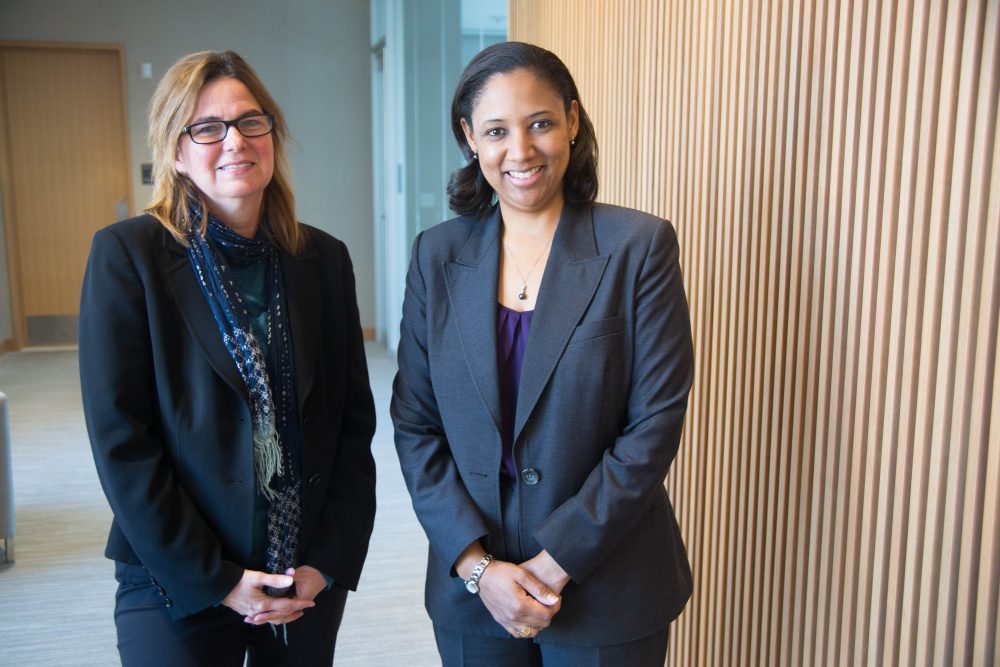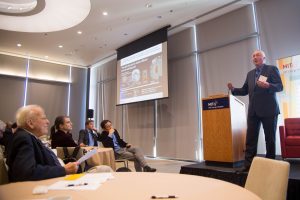
While sharing the research philosophy behind the Low-Carbon Energy Centers launched by the MIT Energy Initiative, Jeffrey Grossman, a professor of materials science and engineering, has found a lot to capture his enthusiasm: “What’s so exciting about these centers is that both faculty who are already working in the area, as well as faculty who have been interested in it but whose work isn’t yet directly related, are coming together under one roof to think about the most important challenges we face on the way towards achieving a low-carbon future.” Grossman is co-director of the Center for Energy Storage Research along with Yang Shao-Horn, also of materials science and engineering, and shared these thoughts at MITEI’s Annual Research Conference, which was held in October 2016. He added: “It’s these kinds of intersections where true innovation happens, and the centers provide a framework for them to occur among faculty, students, and our industry collaborators in ways that will dramatically accelerate the pace of progress.”
The intersections created by the Low-Carbon Energy Centers are connecting a network of MIT faculty, researchers, and students as well as professionals from industry and government—building on MITEI’s ten-year history of facilitating these types of connections. Industry professionals play a dual role lending input from on-the-ground energy operations and supporting the centers’ overarching mission. This mission, derived from MIT’s Plan for Action on Climate Change, is to advance specific technology areas key to enabling the transition to a low-carbon energy future.
Across the Institute, faculty members are committed to charting this path. In the energy storage center alone, Grossman said, there are more than 30 MIT faculty collaborating on solutions. At the Annual Research Conference, the directors of all of the centers gathered to share their work to date and their plans for the future with an audience of MITEI member companies and other guests.
Vladimir Bulović, MIT’s associate dean for innovation and co-director of the Center for Solar Energy Research, said, “There are 55 MIT faculty spanning 14 departments who in some way work on solar technology, from the nascent stage of exploring optimal materials to the point where we ask, what is the right system to deploy, and how will the grid react to our introduction of new solar technologies? Finally, we have a center to focus on where we can go ahead and coalesce and crosslink these different efforts.” Bulović’s co-director of the center is Moungi Bawendi, the Lester Wolfe Professor of Chemistry at MIT.
Research frontiers
Professors Kristala Prather of chemical engineering and Angela Belcher of biological engineering, co-directors of the Center for Energy Bioscience Research, said that the research in their center embodies, as Prather said, “the future of biology.” Prather, Belcher, and their colleagues explore how to engineer DNA to control living cells, which leads to tailored biochemical solutions to real-world challenges, Prather said. The possible energy applications of their work are broad. “We’re reimagining and reinventing new solutions to pressing challenges in the fields of renewables, cleaner fuel sources, extraction, sensors, infrastructure, storage, clean-up, chemical processing, and production,” Belcher said. “Life is our toolbox. Nature is our guide.”
Researchers at the Center for Fusion Energy Research would have to travel to the Sun to see their chosen mode of energy production occurring in its natural habitat. Center co-director Dennis Whyte, head of the Department of Nuclear Science and Engineering, and Director of the Plasma Science and Fusion Center (PSFC) acknowledged there are some challenges facing fusion as an energy source but this fall, researchers achieved an important milestone. The team set a new world record for plasma pressure, one key to creating fusion energy, in MIT’s Alcator C-Mod tokamak reactor. The reactor’s congressional funding ceased at the end of September, but the new record brought researchers that much closer to realizing fusion as a reality. “These challenges are well worth tackling as fuel [from fusion] is inexhaustible, and it’s intrinsically safe. It’s a risk, in terms of energy investment, that’s absolutely worth it to take,” said Whyte. He added that the initial hurdle for fusion researchers was to develop small-scale reactors in order to prove that fusion was a possibility. He specifically highlighted the development of a breakthrough magnet technology for fusion that could be the basis of a new, improved, much more compact and adaptable reactor. This new magnet technology could also have additional applications in other large-scale systems and for the energy industry. Since the Annual Research Conference, the fusion center has also welcomed co-director Anne White, the Cecil and Ida Green Associate Professor in Nuclear Engineering.

Dennis Whyte, head of the Department of Nuclear Science and Engineering, and co-director of the Center for Fusion Energy Research.
The Center for Electric Power Systems Research considers how these low-carbon energy technologies—from nuclear and biofuels to solar and wind—will work together on the grid. Francis O’Sullivan, MITEI’s director of research, and Ignacio Perez-Arriaga of the Sloan School of Management, discussed the center’s long-term goals and mode of operation. The activities of the center focus on three distinct tenets: moving toward a decarbonized power sector, advancing the operation and control of user-centered power systems, and achieving universal energy access. “We have the physical power system, the mechanism through which it operates, and the rules of the game,” said O’Sullivan. “This system has worked well, but we’re in a state of transition today.” The charge of the center, he continued, “is to take on those areas of research where there’s crossover, and to bring the best of MIT to bear on solving these new challenges.”
The center will partially draw on the findings of the Utility of the Future study report, released in December 2016, to inform its research. The study focuses on several areas of interest for a future electric grid, from electrification in developing countries and energy storage to natural gas distributed generation and computational modeling. The aim of this study, and of the center as a whole, Perez-Arriaga said, is “a comprehensive view of the power system and the challenges facing the energy transition to a decarbonized energy economy.”
Directors of the other Low-Carbon Energy Centers are: Bilge Yildiz and Ju Li (both of nuclear science and engineering), Center for Materials in Energy and Extreme Environments; Bradford T. Hager (earth, atmospheric, and planetary sciences) and T. Alan Hatton (chemical engineering), Center for Carbon Capture, Utilization, and Storage; and Jacopo Buongiorno (nuclear science and engineering) and John Parsons (MIT Sloan Management School), Center for Advanced Nuclear Energy Systems.
Modeling pathways to bring technology from lab to field
On another panel, O’Sullivan described the techno-economic assessment program researchers have created “to complement and contextualize the Low-Carbon Energy Centers’ lab-based research work.” In order for innovations emerging from the centers’ work to ultimately be deployed, thought must be given to how these new technologies will compete and interact with the existing energy system. “The techno-economic assessment program is structured in a manner that reflects this need,” O’Sullivan said. “We are not going to try and pick winners, rather we are working to identify the system’s needs and the characteristics new technologies require in order to succeed in the evolving energy market landscape.”
O’Sullivan was joined by his research team, whose work informs models of how all of the developing forms of energy discussed will fit into the current energy system. The group— which includes Patrick Brown, Emre Gencer, and Apurba Sakti—is exploring how U.S. power systems are reacting to increased renewables penetration, for example, as well as pathways to integrate physically realistic storage onto the grid.
Patrick Brown, a MITEI postdoc, framed his research on solar and wind resources within the larger issue of climate change. “If we’re going to stay within the two-degree Celsius high point for global temperature increase, we have to completely decarbonize the global power system in 20-30 years,” he said. “I try to understand how a future power system dominated by zero-carbon energy sources would operate, and what technological and regulatory changes are important for realizing that future as quickly as possible.”
Institute-wide engagement
MIT graduate students and postdocs shared their work in the energy sector at a poster session during the conference. Poster topics ranged from studies of silicon photovoltaics to explorations into power plant cybersecurity. Jimi Oke, a postdoc in civil and environmental engineering, presented a poster on city-dwellers’ responses to changes in energy policy and mobility developments. “We collect data from cities across the globe,” Oke said. With that information, Oke and his colleagues “create prototypical cities where we can observe behavior and outcomes.” Using their simulation laboratory, the team can begin to decipher the effectiveness of changes in energy and environmental policy and determine if they translate into changes in citizens’ energy consumption and mobility patterns.
Jeffrey Grossman summed up the MIT community’s desire to advance research in vital technology areas by coming together through the centers. “The feedback from the faculty is that they couldn’t be happier and more excited about the centers. They want to work on what’s relevant—things that are really going to make a difference. The only way to do that is to work with industry and to do this really deep dive on the powerful combination of technical and economic analysis.”